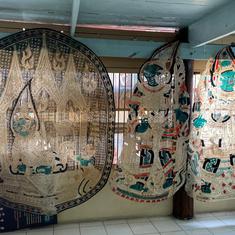Preview: The Congress eyes a comeback in Punjab, but Arvind Kejriwal’s AAP poses a big challenge
Nearly 1.98 crore voters chose from among 1,145 candidates for 117 Assembly seats in the state.

Punjab had its Assembly polls in a single phase this year on February 4. The public had turned out in large numbers to vote for the state’s 117 seats and the overall turnout was 70%. However, repolling had to be held at 48 polling stations on February 9 after a few Voter-Verified Audit Paper Trail and Electronic Voting Machines reported technical glitches.
Punjab has had a Shiromani Akali Dal-Bharatiya Janata Party alliance leading them for 10 years now. This time’s elections are particularly important for the ruling alliance as they were held right after the Centre’s recent demonetisation move. While the alliance is fighting anti-incumbency waves, arch-rival Congress is hoping to win out of existential concerns. Meanwhile, the new kid on the block – Arvind Kejriwal’s Aam Aadmi Party – is hoping to make major inroads into the state.
The Centre had made “unprecedented” security arrangements for the polls. “Around one lakh security personnel including paramilitary forces have been deployed in these elections,” Punjab Additional Director General of Police VK Bhawra, who was also the nodal officer for state polls, had said.
Exit polls
The exit polls were unclear about who will win in Punjab. An average of the polls gave 55 seats to the Congress and 54 to AAP, in the 117-strong Assembly.
If those numbers are accurate, the result will be a hung Assembly. Two polls actually gave a majority to each of the opposite parties. The Axis poll projected a Congress win, while CVoter gave the state to AAP.
But all the exit polls were clear about one thing: Punjab’s voters are kicking out the incumbent SAD-BJP government. None of the exit polls gave the alliance seats in the double digits. The highest projected seat share for the alliance was nine, from Today’s Chanakya – down from the 58 they had won in 2012. Axis gave them as few as six seats.
In the fray
The SAD-BJP alliance is fighting anti-incumbency, while the Congress is looking at Punjab to help keep the party alive there. The AAP-Lok Insaf Party is hoping to gain a foothold there, or maybe even a surprise win.
The Congress expects Navjot Singh Sidhu to draw several votes. He had left the BJP after alleging that he was not being allowed to work for the state. His wife has also joined the Congress. Amarinder Singh is the chief ministerial candidate of the Congress party. SAD’s Parkash Singh Badal is seeking a sixth term as chief minister.
Both Singh and Badal – the two chief ministerial candidates – had contested from Lambi. Although AAP has not officially named its chief ministerial candidate, reports suggested stand-up comedian and party legislator Bhagwant Mann could be the one picked. However, the new entrant in Punjab politics has also banked on Dalit icon Bant Singh, who had joined AAP before the polls.
Of the 117 seats, the major one will be the fight for Lambi, where the Punjab chief minister and Congress chief had both stood. Before the polling day, locals had started referring to Lambi as Punjab’s Kurukshetra, an allusion to the Mahabharata battlefield. Here, AAP had fielded Jarnail Singh – who had shot to fame after he threw a shoe at former Union Home Minister P Chidambaram in Delhi in 2009.
Electoral issues
An agricultural crisis, unemployment and a looming drug problem were the major issues for this year’s election. With nothing much to bank on, the ruling SAD-BJP government had tried to battle the anti-incumbency wave by riding on the legacy of Chief Minister Parkash Singh Badal. The Congress and AAP, on the other hand, had sought to reap an advantage from the public anger against the Akali rulers.
The AAP has played its newbie card in Punjab, seeking that “one chance” to bring in change. In 2014, the party had pulled off a shocker by winning its first four Lok Sabha seats in Punjab. Besides this, Arvind Kejriwal has also turned the drugs narrative into a national storyline and managed to whip up the simmering anger against the Akalis.
For the Congress, Punjab can prove to be its comeback state. It has put former chief minister Captain Amarinder Singh in charge, and added firepower from strategist Prashant Kishore’s team in an effort to take the state. Corruption, inflation and law and order were Singh’s biggest campaign planks. To counter AAP, the party has played on the fact that it is not a purely Punjab-based party. The Congress has also built the narrative that an AAP government would be remote-controlled from Delhi.
The 2012 elections
The SAD-BJP alliance had won the 2012 Assembly elections in Punjab. The ruling alliance, led by Parkash Singh Badal, had won a total of 68 seats out of 117. Individually, SAD had bagged 56 of the 94 seats it had contested in, while the BJP won 12 out of their 23. The Congress had got 46 seats.









